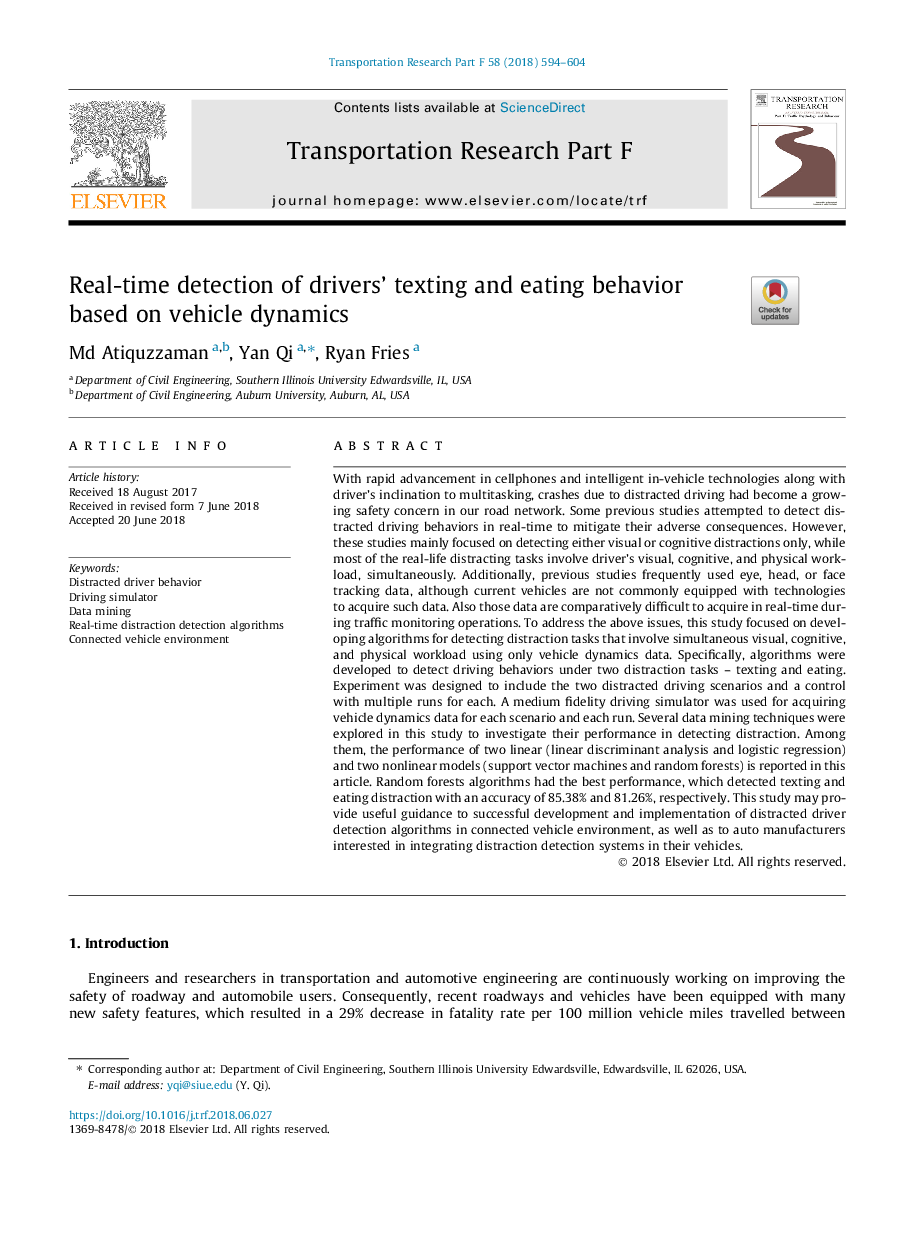| کد مقاله | کد نشریه | سال انتشار | مقاله انگلیسی | نسخه تمام متن |
|---|---|---|---|---|
| 7257659 | 1472429 | 2018 | 11 صفحه PDF | دانلود رایگان |
عنوان انگلیسی مقاله ISI
Real-time detection of drivers' texting and eating behavior based on vehicle dynamics
ترجمه فارسی عنوان
تشخیص زمان واقعی پیامک و رفتار خوردن رانندگان بر اساس دینامیک خودرو
دانلود مقاله + سفارش ترجمه
دانلود مقاله ISI انگلیسی
رایگان برای ایرانیان
کلمات کلیدی
رفتار راننده حیرت انگیز، شبیه ساز رانندگی، داده کاوی، الگوریتم های تشخیص حسی واقعی زمان، محیط خودرو متصل
ترجمه چکیده
با پیشرفت سریع در تلفن های موبایل و تکنولوژی های هوشمند در خودرو، همراه با رانندگی برای چند وظیفه ای، سقوط به دلیل رانندگی منحرف شده، موجب افزایش امنیت در شبکه های جاده ای ما شده است. بعضی از مطالعات قبلی تلاش برای شناسایی رفتارهای رانندگی منحرف در زمان واقعی برای کاهش عواقب ناگوار آنها بود. با این حال، این مطالعات عمدتا بر تشخیص هر دو حواس پرتی بصری یا شناختی متمرکز شده اند، در حالی که بیشتر وظایف منحرف کننده زندگی واقعی، شامل همزمان تمرینات بصری، شناختی و فیزیکی راننده است. علاوه بر این، مطالعات قبلی اغلب از داده های ردیابی چشم، سر و یا چهره استفاده می کنند، اگر چه وسایل نقلیه فعلی به طور معمول با فن آوری برای به دست آوردن چنین اطلاعاتی مجهز نیستند. همچنین این داده ها در زمان واقعی در طول عملیات نظارت بر ترافیک دشوار است. برای رسیدگی به مسائل فوق، این مطالعه بر توسعه الگوریتمی برای تشخیص وظایف حواس پرتی که شامل بارگیری بصری، شناختی و فیزیکی همزمان با استفاده از داده های پویایی خودرو است، متمرکز بود. به طور خاص، الگوریتم های توسعه یافته برای تشخیص رفتار رانندگی تحت دو وظیفه حواس پرتی - پیام کوتاه و خوردن. آزمایش انجام شده شامل دو سناریو رانندگی منحرف شده و یک کنترل با چند اجرا برای هر یک بود. برای دستیابی به اطلاعات پویایی وسایل نقلیه برای هر سناریوی و هر اجرا، از یک شبیه ساز رانندگی متوسط استفاده شد. در این مطالعه چندین تکنیک داده کاوی به منظور بررسی عملکرد آنها در تشخیص حواس پرتی مورد بررسی قرار گرفت. در میان آنها، در این مقاله، عملکرد دو خطی (تجزیه و تحلیل خطی و رگرسیون لجستیک) و دو مدل غیر خطی (ماشین های بردار پشتیبانی و جنگل های تصادفی) گزارش شده است. الگوریتم های جنگل های تصادفی دارای بهترین عملکرد بودند که به ترتیب پیام های متنی و انحراف از خوردن را با دقت 85/38٪ و 76/81٪ تشخیص دادند. این مطالعه می تواند راهنمایی های مفیدی برای توسعه و اجرای الگوریتم های تشخیص راننده راننده در محیط وسیله نقلیه متصل و همچنین تولید کنندگان خودروی علاقه مند به ادغام سیستم های تشخیص حواس پرتی در وسایل نقلیه خود ارائه دهد.
موضوعات مرتبط
علوم انسانی و اجتماعی
روانشناسی
روان شناسی کاربردی
چکیده انگلیسی
With rapid advancement in cellphones and intelligent in-vehicle technologies along with driver's inclination to multitasking, crashes due to distracted driving had become a growing safety concern in our road network. Some previous studies attempted to detect distracted driving behaviors in real-time to mitigate their adverse consequences. However, these studies mainly focused on detecting either visual or cognitive distractions only, while most of the real-life distracting tasks involve driver's visual, cognitive, and physical workload, simultaneously. Additionally, previous studies frequently used eye, head, or face tracking data, although current vehicles are not commonly equipped with technologies to acquire such data. Also those data are comparatively difficult to acquire in real-time during traffic monitoring operations. To address the above issues, this study focused on developing algorithms for detecting distraction tasks that involve simultaneous visual, cognitive, and physical workload using only vehicle dynamics data. Specifically, algorithms were developed to detect driving behaviors under two distraction tasks - texting and eating. Experiment was designed to include the two distracted driving scenarios and a control with multiple runs for each. A medium fidelity driving simulator was used for acquiring vehicle dynamics data for each scenario and each run. Several data mining techniques were explored in this study to investigate their performance in detecting distraction. Among them, the performance of two linear (linear discriminant analysis and logistic regression) and two nonlinear models (support vector machines and random forests) is reported in this article. Random forests algorithms had the best performance, which detected texting and eating distraction with an accuracy of 85.38% and 81.26%, respectively. This study may provide useful guidance to successful development and implementation of distracted driver detection algorithms in connected vehicle environment, as well as to auto manufacturers interested in integrating distraction detection systems in their vehicles.
ناشر
Database: Elsevier - ScienceDirect (ساینس دایرکت)
Journal: Transportation Research Part F: Traffic Psychology and Behaviour - Volume 58, October 2018, Pages 594-604
Journal: Transportation Research Part F: Traffic Psychology and Behaviour - Volume 58, October 2018, Pages 594-604
نویسندگان
Md Atiquzzaman, Yan Qi, Ryan Fries,
